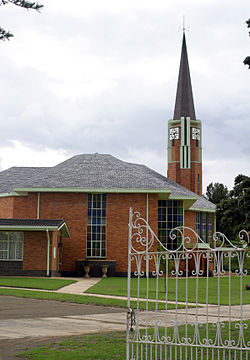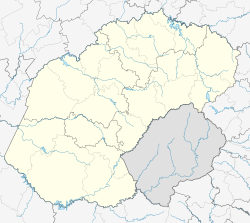Petrus Steyn
| Mamafubedu (Petrus Steyn) | |
|---|---|

Petrus Steyn Church
|
|
|
|
|
| Coordinates: 27°39′00″S 28°08′00″E / 27.65000°S 28.13333°ECoordinates: 27°39′00″S 28°08′00″E / 27.65000°S 28.13333°E | |
| Country | South Africa |
| Province | Free State |
| District | Thabo Mofutsanyane |
| Municipality | Nketoana |
| Established | 1912 |
| Area | |
| • Total | 11.0 km2 (4.2 sq mi) |
| Elevation | 1,700 m (5,600 ft) |
| Population (2011) | |
| • Total | 12,893 |
| • Density | 1,200/km2 (3,000/sq mi) |
| Racial makeup (2011) | |
| • Black African | 95.7% |
| • Coloured | 0.3% |
| • Indian/Asian | 0.5% |
| • White | 3.4% |
| • Other | 0.1% |
| First languages (2011) | |
| • Sotho | 83.2% |
| • Zulu | 7.4% |
| • Afrikaans | 4.6% |
| • Sign language | 2.0% |
| • Other | 2.8% |
| Postal code (street) | 9640 |
| Area code | 058 |
Petrus Steyn is a small farming town between Tweeling and Kroonstad, 35km north-east of Lindley in the Free State province of South Africa. It is at the centre of an agricultural area known for wheat, maize, sunflower, potato, cattle,sheep production and forms part of the breadbasket in the Free State.
The town was supposed to be called Concordia, but the widow of the late Mr Petrus Paulus Steyn sold it on condition that the new town be named after her husband. The farm Sterkfontein was then sold out of the will of the Mr Steyn for the price of 4 pounds & 5 shillings per acre, which was bought on 11 October 1912, the official date that Petrus Steyn, the town, was established.The Renoster River has its origin on erf 502, just next to the Petrus Steyn family grave yard.
An Afrikaans Language Monument was created out of stones stacked by visitors on 14 August 1975, in celebration of the centenary of the Afrikaans Language.
The Ox Wagon Wheel monument was erected in 1938, during the centenary celebrations of the Great Trek. Here, ox wagon tracks are preserved on a concrete slab. The above two monuments are found at the town civic centre at Dirkie Uys square, named after Dirkie Uys, the son of Piet Uys who led a punitive expedition against the Zulus after they killed Piet Retief and his 70 men at Dingane’s kraal (settlement).
On the R707 towards Frankfort, at a farm called Hooggelegen, three monuments of historical significance are found. These commemorate the 1938 centenary of the Great Trek and the rebels who died during the Maritz rebellion of 1914.
The sandstone parsonage of the local Dutch Reformed Church was declared a national monument in 1988 and is on Reitz street.
The family grave yard of Petrus Steyn was laid out in 1898 under the oak tree.
General CH Olivier was one of the delegates sent to sign the Peace Treaty of Vereeniging to end the Second Anglo Boer War in May 1902. He was a Boer General and lived in the Lindley district where he had a farm. He lies buried at the old Petrus Steyn cemetery.
Elandskop Hill is located west of the town and during the Second Anglo-Boer War 1899-1902 was an excellent observation post for the Boer and British. For the Boer forces it was a particularly important heliograph station, especially because the headquarters of General De Wet and also the Orange Free State Government were located there for a long time near the present-day town.
...
Wikipedia



